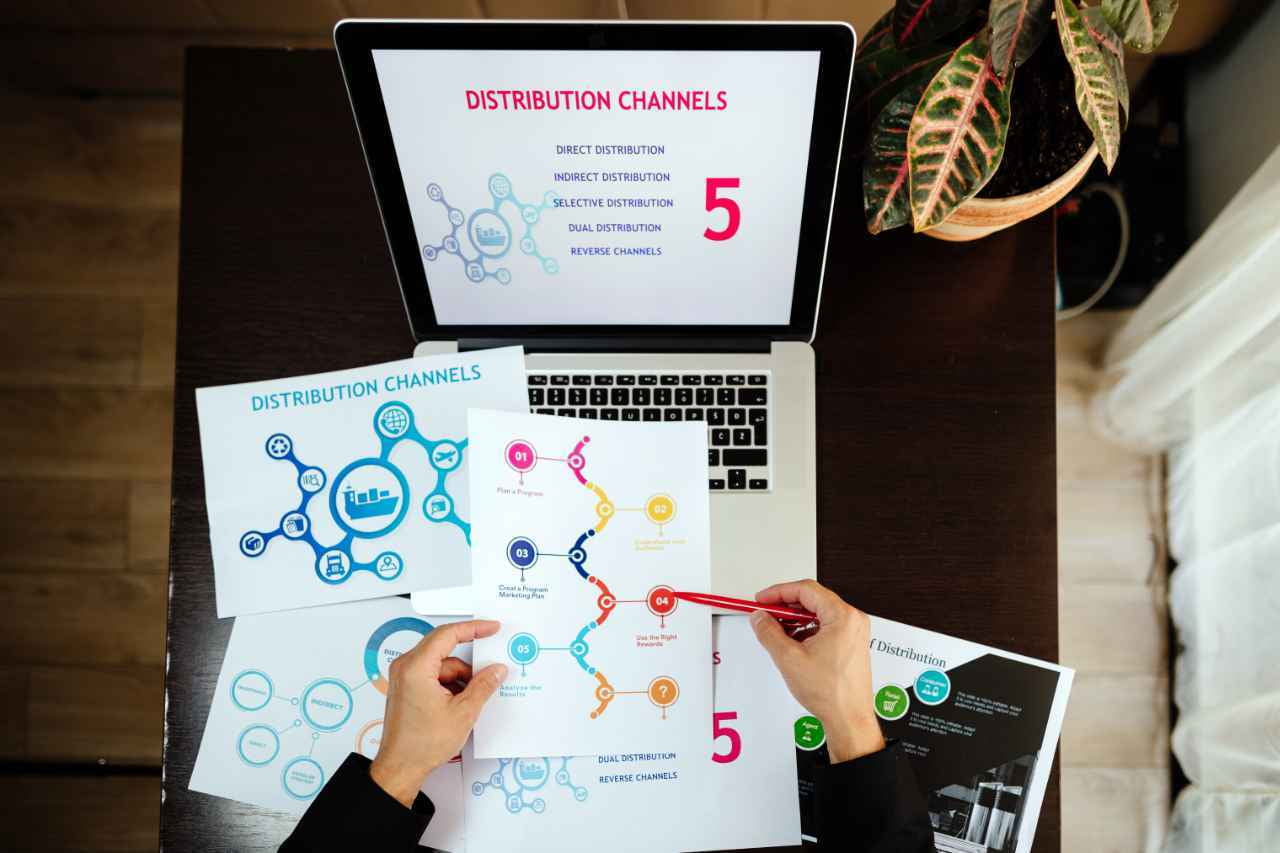
Your current and potential customers search for and expect to find your brand on the channels they frequent most. And once they find you, they expect a consistent, branded experience across all those channels, which is an important reason why you need a channel strategy.
On the right channels, you'll be able to engage potential customers where they are and make them more likely to purchase from you.
In this guide, we'll cover different channels your brand might use when developing a channel marketing strategy, the steps and best practices for developing a channel strategy, and what it means to have a multichannel strategy or omnichannel strategy.
Why You Need a Marketing Channel Strategy
Why You Need a Marketing Channel Strategy
In the modern business world, there are many different avenues, platforms, and campaigns that companies use to connect with their target audience. Your "channels" are the routes that you pick when you're looking for the best way to speak to your customers in the places and environments that they frequent most.
Marketing channel strategy is about finding the best way to expose your services, products, and brand identity to possible customers. For instance, if you're a local company with a simple set of products that require very little support to use, such as a regional bakery, you might use direct marketing and a few digital channels like social media to drive attention to your organization. On the other hand, if you're a sophisticated technology company with customers that need support implementing your products, you may work with value-added resellers and partners to boost your sales channel strategy.
There are many different types of channel strategies to consider depending on the kind of business that you run and the customers you need to serve. One of the first decisions you'll need to make is whether you're a B2B or B2C business.
B2B brands typically use a "direct" or "indirect" sales channel strategy to build revenue. Direct sales are the simplest approach because they allow the vendor to sell to the customer directly.
On the other hand, indirect sales involve using "channel partners" and intermediaries to support sales. An indirect sales channel strategy may include using retail to sell through an online or offline store. Additionally, some B2B vendors also sell through "value-added resellers" to improve their access to new customers.
In the world of consumer sales, the question "what is channel strategy?" often leads to different answers. Most B2C or business-to-consumer companies will use various direct and indirect marketing strategies both online and offline, including social media, SEO, and content marketing. Much of the time, these channels are connected through either a multichannel strategy or omnichannel strategy – we'll discuss those soon.
Importantly, there's no one-size-fits-all marketing channel strategy. Through avenues like social media and email marketing strategies started as consumer-based solutions, many B2B companies now use these methodologies too.

Types of Marketing Channels You Can Leverage
Types of Marketing Channels You Can Leverage
Before we go any further, it's important to define the features that make a marketing channel.
- A channel is any touchpoint where you can deliver a marketing message and connect with customers – or where you can enlist someone else (such as a partner or loyal customer) to deliver that message for you.
- Each channel opens up unique ways to convince your target customers to purchase from you.
- You must be able to measure the success of your marketing efforts on every channel you use.
Below we'll discuss the most popular marketing channels you can leverage:
Multi-Channel
Multi-Channel
A multichannel strategy involves carefully selecting several marketing channels and using them to connect with both potential and current customers.
For instance, if you use your website, a company blog, a Twitter account, email marketing campaigns, and PPC ads to market your brand, then you're using a multichannel strategy. Any strategy involving at least two channels counts as multichannel, which makes up the vast majority of marketing strategies.
Just like with any channel marketing strategy, a crucial part of a multichannel strategy is selecting the channels your target market frequents most. Selecting many channels without a rationale isn't an effective multichannel strategy.
Omnichannel
Omnichannel
A brand with an omnichannel strategy provides a seamless, coherent experience across all of its marketing channels.
Many people think omnichannel strategy and multichannel strategy are synonymous, but this isn't true. An omnichannel strategy builds on a multichannel marketing strategy and kicks it up a notch.
All omnichannel experiences will use multiple channels, but not all multichannel experiences are omnichannel. You can have amazing mobile marketing, engaging social media campaigns, and a well-designed website. But if they don't work together, it's not omnichannel.

If you use an omnichannel strategy, your brand will project the same goals, messaging, voice, imagery, and all other aspects of its branding across all its channels. The way you deliver this message will be optimized for each channel, but the core branding will stay unified.
This way, all members of your audience will receive a consistent picture of what your brand stands for, no matter what channel they encounter your message on. And whenever they transition to a new channel as they move through the marketing funnel, they'll still receive the same integrated brand experience.
Steps to Developing a Marketing Channel Strategy
Steps to Developing a Marketing Channel Strategy
Now that you understand what makes a channel, and the basics of multichannel and omnichannel strategies, let's dive into best practices for developing a stellar channel marketing strategy. Follow these seven steps for channel strategy success.
Maximizing Your Campaigns
Maximizing Your Campaigns
Putting together an omnichannel strategy is usually best. It helps you establish brand consistency, ensures your brand will be memorable for the right reasons and leaves no questions about what you stand for.
Decide on the goals, messaging, imagery, and brand voice you'd like to project across all of your channels and how you can deliver an optimal experience for each channel. Also, determine how each channel fits into your integrated brand experience and ultimately convinces an audience member to purchase from you.
Set goals for each channel you choose
Set goals for each channel you choose
Now that you've selected which channels to focus on, it's time to set measurable goals to track the success of your channel marketing strategy. Each channel will likely have a different main goal or goals, depending on where each fits into the buyer's journey. Also, you're allowed to set more than one goal for a channel, as long as every goal is measurable.
You'll want to measure leads generated directly through at least one of your channels. And of course, you'll also need to measure the sales generated as the result of at least one marketing channel.
For example, you might track traffic to your site as a result of SEO and content marketing but measure your brand's own social media campaigns based on engagement or by leads generated from campaigns. You might also track leads generated via word of mouth (yes, word-of-mouth marketing can be measurable, especially if you use a referral program as one of your channels!)
Meanwhile, you might track purchases motivated by an affiliate or influencer campaign and both click-through rate and purchases made as a result of an email campaign.
Understand and use best practices for each channel you choose
Understand and use best practices for each channel you choose
To optimize your channel marketing strategy, you'll need to apply best practices for each channel you choose. Follow the links below to learn about best practices for some of the most popular marketing channels:

- Email marketing
- Social media marketing
- Content marketing
- Pay-per-click (PPC) advertising
- Social media advertising
- Influencer marketing
- Affiliate marketing
- Brand ambassadors
- Word of mouth
- Referral marketing
Collect data and use it to refine your strategy
Collect data and use it to refine your strategy
Don't just set up your channel strategy and leave it be. Regularly collect data on the measurable goals you set for each channel, and use that data to help you refine each piece of your channel marketing strategy.
It's also recommended to continue collecting data on your audience's habits and needs. The channels they frequent most may change as their needs evolve – and if this happens, your channel strategy should change accordingly.
Creating a Content Marketing Channel Strategy
Creating a Content Marketing Channel Strategy
A content strategy is a plan in which you use content (audio, visual, and/or written) to achieve your business goals. A successful content strategy will attract your target audience at every stage of the funnel and keep them engaged even after a purchase.
Content marketing helps businesses prepare and plan for reliable and cost-effective sources of website traffic and new leads. If you can create just one blog post that gets a steady amount of organic traffic, an embedded link to an ebook or free tool will continue generating leads for you as time goes on — long after you click "Publish." The reliable source of traffic and leads from your evergreen content will give you the flexibility to experiment with other marketing tactics to generate revenue, such as sponsored content, social media advertising, and distributed content. Plus, your content won't just help attract leads; it will also educate your prospects and generate awareness for your brand.
The most important aspect is determining the type of content you want to create. There are a variety of options out there for content you can create, from written content like ebooks and blog posts to audio content like podcasts. Now, it's time to start coming up with ideas for your next content project. For example, Buzz Sumo offers a number of market research tools, one of which uses social media shares to determine if a piece of content is popular and well-liked. This information helps you see which content ideas would do well if you were to create content about them.
Lastly, you'll need an editorial plan for the channel. This will map to your global editorial calendar — but doesn't identify dates or times yet. The purpose of the editorial plan is to define velocity, tone, desired action, and structure for the content for this channel.
For example, for your website content, you might have the following:
Number of Posts: Three posts per day
Tone: Friendly, funny, and with a tongue-in-cheek attitude
Desired action: We want users to click through to the blog
Structure — 1500 to 3000-word post, plus pictures (if applicable) and a "conversion link."

Channel Marketing Strategy
Channel Marketing Strategy
Today's consumers are more empowered, informed, and demanding than ever before. They want their favorite brands to understand their needs, deliver unforgettable experiences, and provide consistency from one avenue to the next. In other words, they want the perfect channel strategy. As the touch-points companies use to connect with their clients, channels are constantly changing and evolving.
For the most part, the average organization won't have enough time or budget to be present on every channel. This means that brands need to focus on choosing the right types of channel strategy for their identity and their audience. Universal Creative Solutions provides a marketing operations strategy to help you find the right mix of channels to use for channel marketing strategy. This may involve developing an implementation plan on how to execute your specific channel strategy to boost brand awareness and get your products or services in front of more people. Schedule a consultation call with us and let us help you increase brand exposure for your company.

